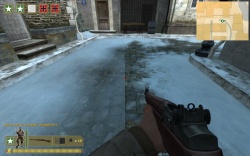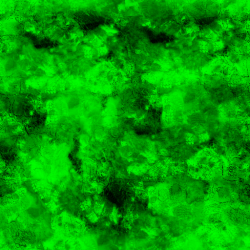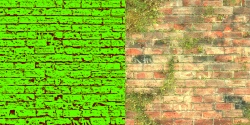$blendmodulatetexture
Jump to navigation
Jump to search

Without vs With. The technique was first used in  Day of Defeat: Source's snow maps, such as Kalt.
Day of Defeat: Source's snow maps, such as Kalt.

The green channel of  Day of Defeat: Source's
Day of Defeat: Source's 
Several (non-snowy)
 Left 4 Dead series materials also use this texture, under a different name.
Left 4 Dead series materials also use this texture, under a different name.
ground/snowblendtexture.vtf.Several (non-snowy)
$blendmodulatetexture is a material shader parameter for the LightmappedGeneric and WorldVertexTransition shader available in all ![]() Source games since
Source games since ![]() Source 2006. It changes the transition between the textures from a smooth, linear gradient to one "stamped" with a pattern.
Source 2006. It changes the transition between the textures from a smooth, linear gradient to one "stamped" with a pattern.
$blendmodulatetexture wherever possible, as the improvement in visual quality is immense!Caveats
- Incompatible with $normalmapalphaenvmapmask in
 . Works in
. Works in  . (use $envmapmask instead).
. (use $envmapmask instead).
- Todo: Only in later games? If so, which?
- Incompatible with $selfillum in



 .
. - Incompatible with $bumpmap and $detail being used at the same time, in
 Alien Swarm.
Alien Swarm. - Using
$blendmodulatetexturewith $detail will cause a major graphical issue ( stripes over the texture ), except in and
and  .
. - Incompatible with $detailblendmode 7 in

 and 9 in
and 9 in 
- In
 Source 2006,
Source 2006,  Source 2007, and
Source 2007, and  Team Fortress 2, incompatible with $basetexturetransform and $detail.
Team Fortress 2, incompatible with $basetexturetransform and $detail. - In
 Source 2006, also incompatible with $envmaptint and $envmapmask.
Source 2006, also incompatible with $envmaptint and $envmapmask. - In
 Alien Swarm, modulation textures are not aligned correctly. Use
Alien Swarm, modulation textures are not aligned correctly. Use $blendmasktransform "center .5 .5 scale 1 -1 rotate 90 translate 0 0"to fix them up. - In
 Alien Swarm, not compatible with $bumptransform.
Alien Swarm, not compatible with $bumptransform.
In some additional cases, textures will blend as if $blendmodulatetexture were not used:
- Does not display when viewed through water. Todo: Only in earlier games?
- Does not display when illuminated with player's flashlight in
 Half-Life 2. This is fixed in
Half-Life 2. This is fixed in  Mapbase.
Mapbase. - Does not display in the Hammer Editor in most games. Known exceptions include
 Counter-Strike: Global Offensive,
Counter-Strike: Global Offensive,  Portal 2,
Portal 2,  Garry's Mod,
Garry's Mod,  Left 4 Dead 2, and
Left 4 Dead 2, and  Mapbase.
Mapbase.
Parameters
$blendmodulatetexture
$blendmasktransform
Blend Modulation Textures
Only two color channels are read from the texture:
- Red
- Sharpens. 0 makes the transition binary, 255 effectively disables modulation.
- The red channel of Valve's snow modulation texture is a constant 99, which produces a fairly sharp falloff. Using different values in different places has the potential to produce a more complex effect.
- Green
- Biases in favor of
$basetexture; high-value areas will be the most resistant to modulation. 128 is normal. - The idea is to paint noise and patterns into this channel, so that the edge between the two textures becomes irregular. Valve's snow texture (see right) has lots of ragged edges in the green channel, and even some bootprints. There are also lines painted along the edges of the albedo's bricks that give them a tendency to have snow along their edges.
There is not always a need for the texture to be high resolution—high-frequency blends can be produced from low-res textures.
